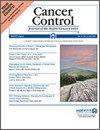Postoperative Radiotherapy in Curatively Resected Esophageal Squamous Cell Carcinoma With Occult Recurrent Laryngeal Nerve Lymph Node Metastasis
IF 2.5
4区 医学
Q3 ONCOLOGY
引用次数: 0
Abstract
ObjectivesSurgery is the mainstream treatment for early-stage esophageal squamous cell carcinoma (ESCC) and occult recurrent laryngeal nerve lymph node metastasis (RLNM) is not uncommon among those with R0 resection. The clinical value of postoperative radiotherapy (PORT) in patients with RLNM only is still controversial.MethodsConsecutive patients with early-stage ESCC treated with R0 resection and pathologically confirmed RLNM only from June 2012 to July 2022 were retrospectively reviewed. PORT, covering the supraclavicular and superior mediastinum area (small T-field) at a dose of 50.4 Gy for 28 fractions, was performed in some patients. Propensity score matching (PSM) was performed to balance the baseline characteristics between patients with or without PORT. Pattern of failure, disease-free survival (DFS), and overall survival (OS) were compared.ResultsAmong the 189 patients identified, 69 (35.5%) received PORT and the other 120 (63.5%) did not. After PSM, 154 patients were included in the matched cohort, including 62 in the PORT group and 92 in the non-PORT group. With a median follow-up of 48 (95% CI: 40.3-55.7) months, 69 patients developed their initial disease recurrence in the whole population and PORT significantly decreased the frequency of local recurrence (61.2% vs 21.4%) among those with recurrent disease. Additionally, in the PSM matched cohort, PORT significantly prolonged patients’ DFS (HR 0.393, P = 0.002) and OS (HR 0.462, P = 0.020). Moreover, PORT remained as the independent factor associated with improved DFS (HR 0.360, P = 0.001) and OS (HR 0.451, P = 0.021) after multivariate Cox analyses. In addition, tumor location and pathological TNM stage were found to be independent prognostic factors associated with survival outcomes.ConclusionPORT is associated with improved DFS and OS in ESCC patients with R0 resection and RLNM only, which warrants future validation.食管鳞状细胞癌根治性切除术后伴有隐匿性喉神经淋巴结转移的术后放疗
目的手术是早期食管鳞状细胞癌(ESCC)的主流治疗方法,在R0切除的患者中,隐匿性喉返神经淋巴结转移(RLNM)并不少见。方法回顾性分析2012年6月至2022年7月期间连续接受R0切除术且病理证实仅有喉返神经淋巴结转移的早期ESCC患者。对部分患者进行了PORT,覆盖锁骨上和上纵隔区域(小T野),剂量为50.4 Gy,28次分次。为平衡使用或未使用 PORT 的患者的基线特征,进行了倾向评分匹配(PSM)。结果在189例患者中,69例(35.5%)接受了PORT治疗,其他120例(63.5%)未接受治疗。经过 PSM,154 名患者被纳入配对队列,其中 PORT 组 62 人,非 PORT 组 92 人。中位随访时间为 48 个月(95% CI:40.3-55.7 个月),在所有患者中,有 69 名患者首次出现疾病复发,而在复发患者中,PORT 能显著降低局部复发的频率(61.2% 对 21.4%)。此外,在 PSM 匹配队列中,PORT 能明显延长患者的 DFS(HR 0.393,P = 0.002)和 OS(HR 0.462,P = 0.020)。此外,经过多变量 Cox 分析,PORT 仍是与 DFS(HR 0.360,P = 0.001)和 OS(HR 0.451,P = 0.021)改善相关的独立因素。结论PORT与仅行R0切除术和RLNM的ESCC患者DFS和OS的改善相关,值得在未来进行验证。
本文章由计算机程序翻译,如有差异,请以英文原文为准。
求助全文
约1分钟内获得全文
求助全文
来源期刊

Cancer Control
ONCOLOGY-
CiteScore
3.80
自引率
0.00%
发文量
148
审稿时长
>12 weeks
期刊介绍:
Cancer Control is a JCR-ranked, peer-reviewed open access journal whose mission is to advance the prevention, detection, diagnosis, treatment, and palliative care of cancer by enabling researchers, doctors, policymakers, and other healthcare professionals to freely share research along the cancer control continuum. Our vision is a world where gold-standard cancer care is the norm, not the exception.
 求助内容:
求助内容: 应助结果提醒方式:
应助结果提醒方式:


